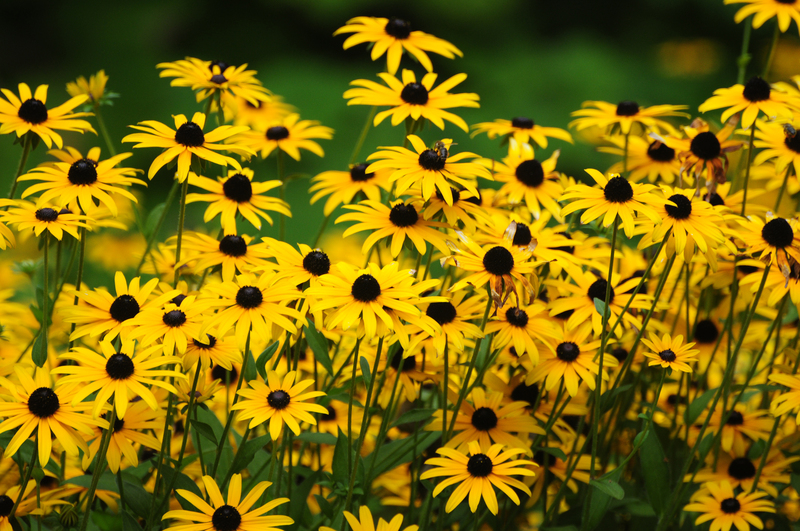Keeping Orchids Vibrant Year-Round
Posted on 03/07/2025
Keeping Orchids Vibrant Year-Round: The Ultimate Guide
Orchids are beloved for their exotic beauty, intricate blooms, and the splash of color they bring to any room. However, keeping orchids vibrant year-round often feels like a daunting task for many plant enthusiasts. Fortunately, with the right knowledge, your orchids can thrive with glowing foliage and long-lasting blooms every season. In this comprehensive guide, you'll discover expert strategies and practical tips for maintaining healthy, vibrant orchids all year long.
Understanding Orchids: What Makes Them Unique?
Orchids belong to one of the largest and most diverse families of flowering plants: Orchidaceae. These intricate and elegant plants have adapted to a wide range of environments, from humid rainforests to arid deserts. Their unique structure and needs set them apart from other popular houseplants.
- Epiphytic Orchids: These grow on trees, extracting moisture and nutrients from air and rain.
- Terrestrial Orchids: Found growing in the ground with more conventional root systems.
- Popular Varieties: Phalaenopsis (Moth Orchid), Cattleya, Dendrobium, and Oncidium are favorites for home growers.
Why Orchids Lose Vibrancy?
To keep orchids looking their best year-round, it's essential to understand common reasons why they lose vibrancy. These include:
- Improper Watering - root rot or dehydration can lead to dull leaves and fewer blooms.
- Lack of Adequate Light - orchids may become leggy or fail to bloom without enough light.
- Poor Humidity - most orchids thrive in higher humidity levels.
- Nutrient Deficiency - lack of proper fertilization impedes flower and leaf development.
- Incorrect Temperature - extremes can stress the plant and reduce vibrancy.

Year-Round Orchid Care Strategies
To maintain vibrant orchids year-round, follow a holistic care routine. Each of the following components plays a vital role:
1. Optimizing Light Exposure for Radiant Orchids
Lighting is one of the most crucial elements for ongoing orchids' vibrancy. Orchids typically flourish under indirect, filtered, or diffused sunlight. Placement is key - too much sun can burn leaves, while too little stalls growth and blooming.
- Phalaenopsis Orchids: Prefer east or west-facing windows, with filtered light.
- Dendrobiums and Cattleyas: Enjoy brighter spots, such as south-facing windows (with protection from direct midday sun).
Expert Tip: If natural light is limited, consider using grow lights. LED grow lamps positioned 6-12 inches above the plant can supplement what your orchid needs, especially in winter months.
2. Watering Techniques to Keep Orchids Thriving
Orchids require a careful watering routine. Overwatering is the leading cause of root rot and lackluster blooms, while underwatering inhibits growth. Here's how to master watering:
- Check the medium: Only water when the potting medium feels nearly dry.
- Soak, Don't Splash: Water thoroughly in the morning, allowing excess to drain completely.
- Avoid leaving water on leaves or in crowns to prevent rot.
- Use lukewarm, distilled, or rainwater for best results.
Frequency changes by season: Water less in winter when growth slows, and more during the growing season (spring/summer).
3. Creating the Perfect Orchid Environment: Humidity and Airflow
Orchids adore higher humidity--generally between 40% and 70%. Low indoor humidity, especially in winter, can stress plants and lead to dull leaves.
- Set up humidity trays (a shallow tray filled with water and pebbles beneath the pot).
- Use a room humidifier during dry seasons.
- Mist the orchids slightly, but avoid water accumulation in crevices.
- Ensure adequate airflow by placing a small fan nearby (not blowing directly on the plant) to prevent mold and disease.
4. Temperature and Seasonal Adjustments for Year-Long Orchid Health
Orchids have preferred temperature ranges:
- Day: 65?-80?F (18?-27?C)
- Night: 55?-65?F (13?-18?C)
Keep orchids away from cold drafts, heating vents, and sudden temperature changes. Some orchids require a nighttime temperature drop to initiate blooming--be sure to research your variety's specific needs.
5. Fertilizing for Year-Round Orchid Vibrancy
Maintain lush, healthy growth by providing your orchid with the nutrients it requires. The best approach is "weakly, weekly"--fertilize with diluted orchid fertilizer every 2 to 4 weeks when orchids are actively growing.
- Use a balanced, water-soluble orchid fertilizer (20-20-20 or similar ratios).
- Flush the potting mix with plain water monthly to avoid salt accumulation.
- Reduce feeding during the dormant or rest period (usually winter).
For intense blooms and bright foliage, look for bloom-boosting fertilizers high in phosphorus (the middle number).
Repotting and Orchid Medium Renewal
Keeping your orchid vibrant also relies on timely repotting. Over time, the potting medium--often bark, sphagnum moss, or a commercial orchid mix--breaks down and restricts airflow to roots.
- Repot every 1-2 years (preferably after flowering).
- Trim any dead or mushy roots during repotting.
- Use a fresh, well-draining orchid medium.
Signs Your Orchid Needs Repotting:
- Roots growing out of the pot and circling the container.
- Medium has broken down, looking soft or spongy.
- Water runs through too quickly or too slowly.
Seasonal Orchid Care Calendar
Maintaining healthy, vivid orchids throughout the year requires attention to seasonal shifts. Here's a breakdown of what to focus on each season:
Spring
- Boost watering and resume regular feeding as new growth appears.
- Increase light exposure as sun intensifies.
- Repot if roots are crowded or medium is degraded.
Summer
- Maintain high humidity; watch for signs of heat stress such as wilting or leaf scorch.
- Continue fertilizing every two weeks; flush pots with water monthly.
- Check for pests, especially mealybugs and spider mites.
Fall
- Gradually reduce watering and fertilization as growth slows.
- Monitor room temperatures as weather cools--avoid drafts.
- Prepare orchids for dormancy (varies by species).
Winter
- Reduce watering significantly; dormant orchids need less moisture.
- Supplement light with grow lamps as daylight fades.
- Keep humidity levels up and avoid placing plants near radiators.
Tip: Observing your orchids carefully throughout the year helps catch potential issues early, ensuring vibrancy and ongoing blooms.
Orchid Problems: Troubleshooting & Remedies
Even with the best care, orchids can face challenges. Here's how to address some common issues that lead to loss of vibrancy:
Dull, Yellowing Leaves
- Possible causes: Overwatering, nutrient deficiency, or too much sunlight.
- Adjust watering routine and move to a shadier spot if sunburn is suspected.
- Begin a balanced feeding regimen.
Wilting or Dropping Blooms
- Possible causes: Sudden temperature changes, drafts, or dry air.
- Stabilize room temperature, increase humidity, and avoid placing orchids near open windows or doors.
Mold, Rot, or Mushy Roots
- Possible causes: Overwatering or poor drainage.
- Immediately remove from pot, trim affected roots, and repot in fresh medium.
- Review watering schedule to avoid recurrence.
Pest Infestations (Mealybugs, Aphids, Spider Mites)
- Remove pests by wiping with a soft, damp cloth or cotton swab dipped in rubbing alcohol.
- Increase airflow and avoid overwatering to deter future infestations.
Regular inspection is vital--catching problems early ensures your orchids stay vibrant and healthy all year round.
Expert Tips for Maximum Orchid Vibrancy
- Rotate your orchids regularly so all sides receive even light and airflow.
- Group orchids close together (without crowding) to create a microclimate of higher humidity.
- Keep leaves dust-free using a soft, damp cloth for optimal photosynthesis.
- Label your orchids by variety to personalize care by species needs.
Advanced Orchid Care: Encouraging Reblooming
The secret to reblooming vibrant orchids often lies in subtle environmental cues:
- For Phalaenopsis, a temperature drop of ~10?F at night for a few weeks can trigger new spikes.
- After blooming, cut the spike an inch above a node to encourage potential side spikes.
- Be patient; some species require a period of rest before reblooming.

FAQs on Keeping Orchids Vibrant
How often should I water orchids to keep them vibrant year-round?
Water when the potting medium is nearly dry--typically every 5-10 days, depending on variety and season. Avoid overwatering!
What is the best fertilizer for orchids?
Use a water-soluble, balanced fertilizer made for orchids, and apply "weakly, weekly" during active growth. Reduce feeding in winter dormancy.
Do all orchids need the same care for year-long vibrancy?
No--while core needs are similar, each species (Phalaenopsis, Cattleya, Dendrobium, etc.) has unique preferences for light, humidity, and temperature. Always research your specific orchid variety.
How do I increase humidity around my orchids?
Group plants together, use a humidity tray, or run a room humidifier, especially in dry indoor climates.
Conclusion: Your Path to Radiant, Year-Round Orchids
Keeping orchids vibrant throughout the year is a rewarding challenge that blends science and art. By understanding orchid needs--light, water, humidity, temperature, nutrients, and appropriate seasonal adjustments--you will enjoy lush foliage, spectacular blooms, and a thriving collection every month of the year.
Whether you're a novice or a seasoned grower, employing these strategies will keep your orchids vivid, healthy, and stunning year-round. Always observe your plants, adapt your care to their cues, and don't be afraid to experiment. The result? A home filled with colorful, radiant orchids--the ultimate testament to your nurturing touch.
Happy Orchid Growing!

